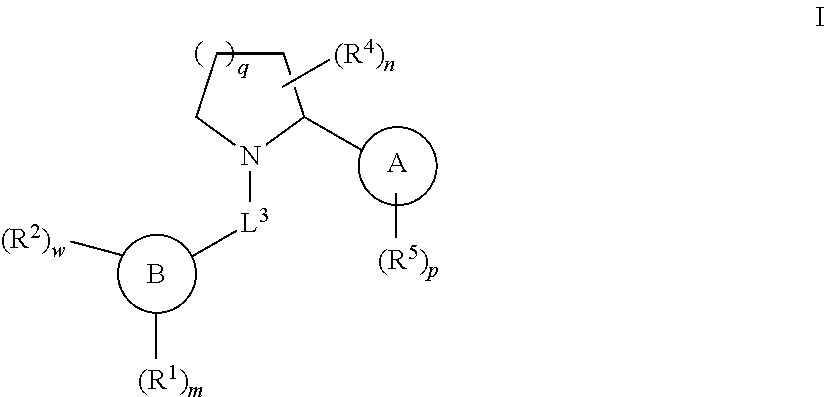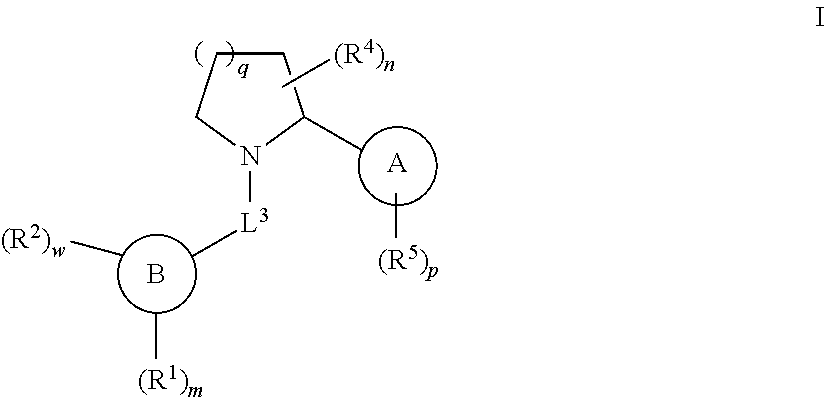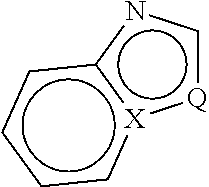CXCR4 inhibitors and uses thereof
a technology of cxcr4 and inhibitors, applied in the field of cxcr4 inhibitors, can solve the problems of poor prognosis and increased risk of metastasis to lymph nodes, liver, lung, brain,
- Summary
- Abstract
- Description
- Claims
- Application Information
AI Technical Summary
Benefits of technology
Problems solved by technology
Method used
Image
Examples
example 1
of I-1
[0456]
[0457]X4-015-3:
[0458]To a cold (−78° C.) solution of KHMDS (0.5 M in toluene, 24 mL, 12.0 mmol) under an atmosphere of argon was added dropwise a solution of X4-015-2 (2.0 g, 10.0 mmol) in THF (20 mL). The mixture was stirred for 1.5 h at this temperature. Afterwards a solution of PhNTf2 (4.3 g, 12.0 mmol) in THF (20 mL) was added dropwise, and after 1 h the reaction was allowed to warm to room temperature. 10% NaOH solution (40 mL) was added, the mixture was extracted with Et2O and the combined organic layers were washed with brine, and dried over Na2SO4, filtered and concentrated. The crude material was purified by flash column chromatography on silica gel (PE:EA=1:2) to give X4-015-3 (2.0 g, 60.1% yield) as a colorless oil. LC-MS (Agilent LCMS 1200-6110, Mobile Phase: from 95% [water+0.05% TFA] and 5% [CH3CN+0.05% TFA] to 0% [water+0.05% TFA] and 100% [CH3CN+0.05% TFA] in 1.6 min, then under this condition for 1.4 min, finally changed to 95% [water+0.05% TFA] and 5% [...
example 2
of I-2
[0468]
[0469]X4-164-2:
[0470]To a solution of X4-164-1 (490 mg, 1.9 mmol) in MeOH / H2O (6 mL / 1 mL) were added Pd / C (49 mg) and ammonium formate (479 mg, 7.6 mmol). The reaction mixture was heated to reflux and stirred until complete consumption of starting material was observed. The suspension was filtered and the filtrate was concentrated under vacuum. The resulting residue was purified by column chromatography to give X4-164-2 (316 mg, 64%) as a colorless oil. LCMS (Agilent LCMS 1200-6110, Column: Waters X-Bridge C18 (50 mm*4.6 mm*3.5 μm); Column Temperature: 40° C.; Flow Rate: 2.0 mL / min; Mobile Phase: from 95% [water+0.05% TFA] and 5% [CH3CN+0.05% TFA] to 0% [water+0.05% TFA] and 100% [CH3CN+0.05 TFA] in 1.6 min, then under this condition for 1.4 min, finally changed to 95% [water+0.05% TFA] and 5% [CH3CN+0.05% TFA] in 0.05 min and under this condition for 0.7 min). Purity: 95.29%. Rt=1.19 min; MS Calcd.: 259.2; MS Found: 260.3 [M+H]+.
[0471]X4-164-3:
[0472]To a solution of X4-...
example 3
of I-3
[0476]
[0477]X4-166-5:
[0478]To a solution of compound X4-166-4 (510 mg, 2.2 mmol) and HATU (1.38 g. 3.3 mmol) in THF (15 mL) was added DIPEA (730 μL, 4.4 mmol) at 0° C. The mixture was stirred at room temperature for 0.5 h and then a solution of compound X4-166-3 (500 mg, 2.4 mmol) in THF (5 mL) was added at 0° C. After stirring at room temperature for 2 hours, the mixture was quenched with water (50 ml) and the solvent was evaporated in vacuo. The resulting mixture was extracted with EtOAc (50 mL×3). The combined organic layers were dried over anhydrous Na2SO4 and concentrated in vacuo to give X4-166-5 (800 mg, 79%) as a brown solid, which was used in the next step without further purification. LCMS (Agilent LCMS 1200-6120, Column: Waters X-Bridge C18 (50 mm*4.6 mm*3.5 μm); Column Temperature: 40° C.; Flow Rate: 2.0 mL / min; Mobile Phase: from 95% [water+10 mM NH4HCO3] and 5% [CH3CN] to 0% [water+10 mM NH4HCO3] and 100% [CH3CN] in 1.6 min, then under this condition for 1.4 min,...
PUM
 Login to View More
Login to View More Abstract
Description
Claims
Application Information
 Login to View More
Login to View More - R&D
- Intellectual Property
- Life Sciences
- Materials
- Tech Scout
- Unparalleled Data Quality
- Higher Quality Content
- 60% Fewer Hallucinations
Browse by: Latest US Patents, China's latest patents, Technical Efficacy Thesaurus, Application Domain, Technology Topic, Popular Technical Reports.
© 2025 PatSnap. All rights reserved.Legal|Privacy policy|Modern Slavery Act Transparency Statement|Sitemap|About US| Contact US: help@patsnap.com



